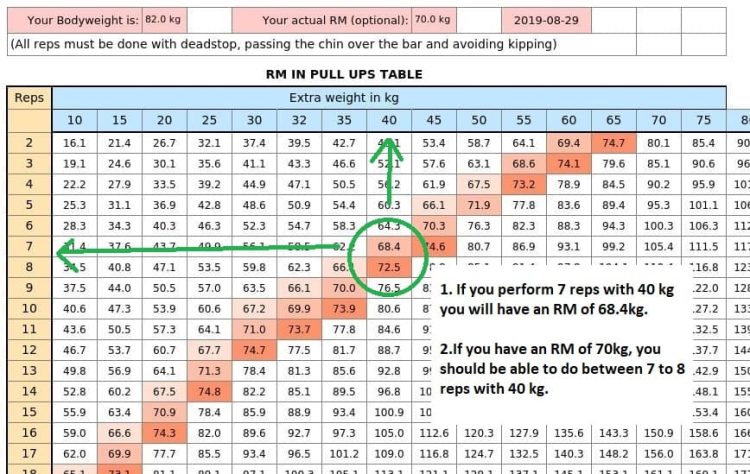The muscle-up is one of the most challenging bodyweight exercises around. Combining a chest-to-bar pull-up with a dip, the muscle-up works virtually every muscle in your upper body. They’ll give you a great core workout, too.
Most dedicated calisthenic exercisers can work up to doing bodyweight muscle-ups. Still, you can make them more challenging by doing them with weight.
How much extra weight should you use? Or how many reps should you be able to do with a given weight, e.g., 20 lbs?
Use our one rep max weighted muscle-ups calculator to discover the answer!
One Rep Max Weighted Muscle-Ups Calculator
The Bar Muscle Up Calculator
Unit weight type:
Option 1: Specific result
Calculator Mode :
Your bodyweight :
Input your RM :
Added weight :
Number of Repetitions :
What Is the One Rep Max Weighted Muscle-Ups Calculator?
Your one-repetition maximum, or one rep max (1RM for short), is the weight you can lift once, but not twice. It’s a measure of your strength.
Level Up Your Fitness: Join our 💪 strong community in Fitness Volt Newsletter. Get daily inspiration, expert-backed workouts, nutrition tips, the latest in strength sports, and the support you need to reach your goals. Subscribe for free!
You can test for your 1RM by lifting progressively heavier weights until you hit failure, but this can be very tiring and stressful. Also, lifting what will probably be a heavy weight to failure could cause injury.
Instead of testing your one rep max, you can use our calculator to estimate how much weight you can lift for a single repetition.
This will be safer and more convenient. Just pick a weight, do as many reps as possible, and then enter your results into the calculator – simple!
In return, you’ll discover your estimated 1RM and also find out how many reps you should be able to do with a lower weight.
All this information can be helpful when designing a new workout. For example, you might want to do sets of five reps with 85% of your 1RM or need to know what weight you should use for sets of ten reps.
Using our one rep max weighted muscle-ups calculator will take a lot of the guesswork out of setting up your next training cycle.
How to Use the One Rep Max Weighted Muscle-Ups Calculator
Our one-rep max weighted muscle-up calculator is straightforward to use. Just follow these steps:
Option 1: Compute a Specific Result
1- Calculator Mode: Reps to RM
- Select your units – kilograms or pounds.
- Enter your body weight.
- Input the amount of additional weight used.
- Input the number of reps you performed.
- Read off your estimated weighted muscle-up 1RM.
2- Calculator Mode: RM to Reps for Specific Weight
- Select your units – kilograms or pounds.
- Enter your body weight.
- Enter your one rep max.
- Enter the amount of weight you want to use.
- Read off the number of reps you should be able to do with your chosen weight.
3- Calculator Mode: RM to Weight for Specific Reps
- Select your units – kilograms or pounds.
- Enter your body weight.
- Enter the one rep max.
- Enter the number of reps you want to be able to do.
- Read off the weight you should be able to lift for the specified number of reps.
Option 2: Calculate the Table
This option produces a table of your 1RM and various percentages and rep maxes based on that result. Print it out and carry it with you so you can quickly determine how much weight to use or how many reps you should do during your workouts.
- Select your units – kilograms or pounds
- Enter your bodyweight
- Enter your 1RM for the weighted muscle-up
- View the table (see example below).

How to Improve your Score
If you care about your weighted muscle-up one rep max, you probably want to improve it. After all, your previous one rep max is yesterday’s news! So, here are the training methods and strategies you need to use to set a new weighted muscle-up 1RM record.
1. Become a muscle-up master
It takes more than strength to become good at muscle-ups; there is a lot of skill involved, too. In fact, muscle-ups are a very technical exercise, and even immensely strong individuals may find them impossible to perform.
So, if you want to increase your weighted muscle-up 1RM, first you need to practice unweighted muscle-ups until you can do perfect reps without thinking about it.
Practice muscle-ups as often as possible, even daily, if you wish. However, avoid taking your sets to failure, as this will force you to take time off for recovery. Doing a few easy sets every day is far better than a couple of hard sets a week when training for skill and proficiency.
Try a technique called greasing the groove, where you do lots of easy sets spread throughout your day, none of which take you anywhere near failure. This is arguably one of the best ways to get better at an exercise without having a big impact on the rest of your workouts.
2. Lose weight
While we’re not suggesting that you should lose muscle mass to get better at weighted muscle-ups, losing fat will probably improve your performance. After all, fat is stored energy and essentially dead weight during the muscle-up movement.
Level Up Your Fitness: Join our 💪 strong community in Fitness Volt Newsletter. Get daily inspiration, expert-backed workouts, nutrition tips, the latest in strength sports, and the support you need to reach your goals. Subscribe for free!
Losing weight means eating a little less and exercising a little more to create a calorie deficit. When faced with this energy shortfall, your body will have no option but to burn fat for fuel, and you’ll gradually lose weight.
Losing weight slowly and gradually is almost always best because a) you won’t lose much muscle, b) you’ll still have plenty of energy for training, and c) you won’t have to suffer extreme hunger.
3. Work on your pull-up and dip strength separately
Weighted muscle-ups combine pull-ups with dips. It makes sense to ensure that you are good at both these exercises before trying to improve (or even learn) how to do muscle-ups.
So, make sure you include plenty of weighted pull-ups and dips in your workouts. Focus on getting really strong in these movements so that, when you put them together to do muscle-ups, neither of them is a weak link that will undermine your performance.

4. Develop your muscle power
You’ll find it a lot easier to complete a muscle up if you do it quickly. Momentum will help you smash through the transition from the pull-up to the dip. Force generated quickly is called muscle power.
Doing muscle-ups will enhance muscle power, but you can do only so many reps before you risk overtraining or get bored with the exercise.
Thankfully, you can build muscle power in other ways. Good power exercises that should transfer well to weighted muscle-ups include:
- Power cleans
- Plyo push-ups
- Plyo pull-ups
- Medicine ball slams
- Push-jerks
- Medicine ball overhead throws
Read more about power exercises here.
5. Focus on low reps and long rests
When it comes to getting good at weighted muscle-ups, you need to ensure that every rep you perform is as good as possible. Scrappy reps or trying to do reps when you are tired will not enhance your long-term performance. Instead, think quality, quality, QUALITY!
So, keep your reps relatively low, stopping a few short of failure, and take long rests between sets to ensure that you are fully recovered. 3-5 minutes between sets is a good place to start, but feel free to rest longer if you wish.
FAQ
1. How often should I retest my weighted muscle-up one rep max?
One of the best things about our weighted muscle-up 1RM calculator is that you can retest your muscle-up max whenever you want. Just input your current bodyweight weight, added weight, and the number of reps performed to determine your current 1RM. So, in theory, you can retest your weighted muscle-up 1RM whenever you train that particular exercise.
This is a stark contrast to doing a “real” 1RM test. Repetition maximum testing is so strenuous that you should only do it once every couple of months, and beginners should probably avoid it altogether.
2. How many reps should I do to estimate my weighted muscle-up 1RM?
All one-rep max calculators use equations to estimate your 1RM. While most allow you to input ten or more reps, you’ll get the most accurate results if you stick to the 3-5 rep range. The lower your rep count, the less of an “educated guess” your one rep max result will be.
3. Are weighted muscle-ups a good exercise for building muscle mass?
Weighted muscle-ups have the potential to build muscle mass but may not be the best choice. The pull-up and dip are done quickly, which means your muscles are not under tension for long. This may limit the muscle-building potential of these exercises compared to doing them separately and more slowly.
So, while the weighted muscle up will undoubtedly make you stronger and more powerful, they may not be ideal for building muscle size.
4. Are weighted muscle-ups safe?
The weighted muscle-up is potentially one of the riskier exercises you can do. The speed of execution, combined with the technical difficulty of the exercise and the loads involved, means that your muscles and joints are put under a lot of stress, which could cause injuries.
That’s not to say that weighted muscle-ups are dangerous. However, they are inherently riskier than exercises like push-ups, dips, and pull-ups, which are done more slowly.
Minimize any potential risks by warming up before your workouts, using the best form possible, increasing your weights and reps slowly, and stopping your sets short of failure.
5. Why do I need to know my weighted muscle-up 1RM?
There are a couple of situations where knowing your weighted muscle-up one rep max may be helpful:
- Program planning – many workouts involve training with a specific percentage of your 1RM, e.g., 75%. While you could estimate this weight, your workout will be more effective if you have a more accurate idea of your 1RM.
- Tracking your progress – when training for strength, it can be hard to tell if you are progressing. Testing and then retesting your muscle-up 1RM every few weeks will reveal if you are getting stronger or if your program is less effective than you hoped it would be.
- You are a competitive CrossFitter – muscle-ups often feature in CrossFit competitions. Knowing your weighted muscle-up 1RM will make it easier to estimate your performance for the workouts you’ll face in your next event.
- Just for fun – why not challenge your training buddies to an informal strength competition? Use our calculator to compare results without doing a real one-rep test.
Related Calculators:
Wrapping Up
Knowing your weighted muscle-up one rep max makes it easier to determine what weights to use for your workouts. And while you COULD do an actual 1RM test, it’s usually more convenient and safer to estimate your result using a 1RM calculator.
Using our one-rep max weighted muscle-up calculator, you can not only estimate your one repetition maximum for the weighted muscle-up but also work out how many reps you should be able to do with a specific weight.
Use this calculator every few weeks to retest your weighted muscle-up 1RM to see how your strength gains are progressing.








